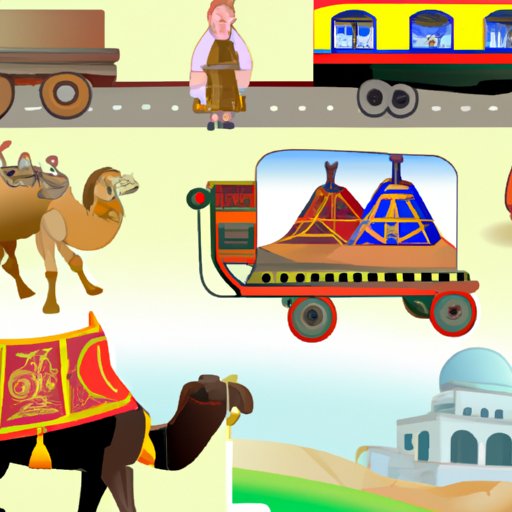Introduction
The Silk Road was an ancient network of trade routes connecting the East and West. It served as a conduit for goods, culture, and ideas to flow from one region to another, enabling global commerce and exchange. This article will explore what transportation technologies facilitated trade along the Silk Road, and how they impacted the growth of this ancient trading system.
Body
Examining the Role of Camels in Facilitating Trade
Camels have long been used as a form of transport in the Middle East, Central Asia, and North Africa. They were first domesticated around 3000 BCE and played a significant role in the development of the Silk Road. As noted by historian David Christian, “Camel caravans were able to cross deserts and mountains where wheeled vehicles could not go.”
Camels had several advantages when it came to transporting goods along the Silk Road. They could carry large loads over long distances, often up to 500 miles in a single journey. They also had an impressive ability to endure harsh conditions, such as extreme heat and cold, making them well suited for traversing the deserts and mountains of Central Asia.
However, there were also challenges associated with using camels for trade. Camels are slow-moving animals, meaning that the journeys took much longer than if they had been done by other means. Additionally, they required constant care and attention, which added to the cost of the journey. Finally, camels were vulnerable to bandits and thieves, who would often attempt to steal the goods being transported.
Analyzing the Benefits of Horse-Drawn Caravans
Horses were another important form of transport along the Silk Road. These animals provided the power needed to pull caravans filled with goods, allowing traders to cover greater distances in shorter periods of time. As noted by historian Peter Frankopan, “Caravans of horses, loaded with spices, silks, jewels and gold, criss-crossed the continent.”
Horse-drawn caravans had several advantages for trade along the Silk Road. They could travel at a faster pace than camels, allowing traders to reach their destinations more quickly. Additionally, the caravans provided protection against bandits, as the presence of the horses and their riders deterred potential attackers. Finally, the caravans allowed traders to carry larger amounts of goods, increasing their profits.
However, there were also challenges associated with horse-drawn caravans. The horses required food and water, adding to the cost of the journey. Additionally, the caravans could only move as fast as the slowest horse, meaning that they were still slower than other forms of transport. Finally, the caravans were vulnerable to attack by bandits, who were often well-equipped and experienced in dealing with travelers.
Assessing the Impact of Wheeled Vehicles on Trade
Wheeled vehicles, such as carts and wagons, were also used to transport goods along the Silk Road. These vehicles had the advantage of being able to move faster than both camels and horses, allowing traders to reach their destinations more quickly. As noted by historian Valerie Hansen, “By the early centuries CE, wheeled carts, wagons, and chariots had replaced pack animals as the primary means of overland transport.”
Wheeled vehicles had several advantages for trade along the Silk Road. They could cover greater distances in shorter periods of time, allowing traders to get to their destinations more quickly. Additionally, they provided better protection against bandits, as the vehicles were more difficult to stop and rob. Finally, the vehicles could carry heavier loads, increasing the profits of the traders.
However, there were also challenges associated with wheeled vehicles. The vehicles required more maintenance than other forms of transport, adding to the cost of the journey. Additionally, the vehicles were easily damaged by rough terrain, meaning that they could not traverse certain areas. Finally, the vehicles were vulnerable to attack by bandits, who often ambushed travelers on the roads.
Investigating Ship-Based Trade Along the Silk Road
In addition to land-based forms of transport, ships were also used to transport goods along the Silk Road. These vessels allowed traders to move large amounts of goods over long distances, allowing them to reach distant markets and increase their profits. As noted by historian Peter Frankopan, “Ships sailed across the Indian Ocean, the Persian Gulf and Red Sea, carrying spices from India and China to ports in the Mediterranean.”
Ship-based trade had several advantages for trade along the Silk Road. It allowed traders to move large amounts of goods over long distances, increasing their profits. Additionally, the ships provided protection against bandits, as the vessels were difficult to board and rob. Finally, the ships were relatively fast, allowing traders to reach their destinations more quickly.
However, there were also challenges associated with ship-based trade. The ships required skilled sailors and navigators, adding to the cost of the journey. Additionally, the ships were vulnerable to storms and pirates, who often attacked vessels in order to steal the goods they were carrying. Finally, the ships were slow compared to other forms of transport, meaning that they could not reach destinations as quickly.
Conclusion
In conclusion, a variety of transportation technologies were used to facilitate trade along the Silk Road. Camels, horse-drawn caravans, wheeled vehicles, and ships all played a role in enabling traders to move goods from one region to another. Each of these methods had its own advantages and challenges, but all of them contributed to the growth and success of the Silk Road.
The transportation technologies used along the Silk Road enabled traders to move goods over long distances, increasing their profits and helping to spread culture and ideas throughout the ancient world. While these methods may seem primitive by today’s standards, they played an important role in the development of global commerce and exchange.
(Note: Is this article not meeting your expectations? Do you have knowledge or insights to share? Unlock new opportunities and expand your reach by joining our authors team. Click Registration to join us and share your expertise with our readers.)
